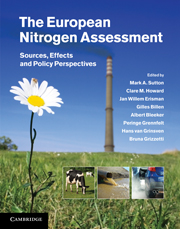Book contents
- Frontmatter
- Contents
- List of contributors
- Foreword
- Summary for policy makers
- Technical summary
- 1 Assessing our nitrogen inheritance
- Part I Nitrogen in Europe: the present position
- Part II Nitrogen processing in the biosphere
- Part III Nitrogen flows and fate at multiple spatial scales
- Part IV Managing nitrogen in relation to key societal threats
- 17 Nitrogen as a threat to European water quality
- 18 Nitrogen as a threat to European air quality
- 19 Nitrogen as a threat to the European greenhouse balance
- 20 Nitrogen as a threat to European terrestrial biodiversity
- 21 Nitrogen as a threat to European soil quality
- Part V European nitrogen policies and future challenges
- Glossary
- Index
- References
21 - Nitrogen as a threat to European soil quality
from Part IV - Managing nitrogen in relation to key societal threats
Published online by Cambridge University Press: 16 May 2011
- Frontmatter
- Contents
- List of contributors
- Foreword
- Summary for policy makers
- Technical summary
- 1 Assessing our nitrogen inheritance
- Part I Nitrogen in Europe: the present position
- Part II Nitrogen processing in the biosphere
- Part III Nitrogen flows and fate at multiple spatial scales
- Part IV Managing nitrogen in relation to key societal threats
- 17 Nitrogen as a threat to European water quality
- 18 Nitrogen as a threat to European air quality
- 19 Nitrogen as a threat to the European greenhouse balance
- 20 Nitrogen as a threat to European terrestrial biodiversity
- 21 Nitrogen as a threat to European soil quality
- Part V European nitrogen policies and future challenges
- Glossary
- Index
- References
Summary
Executive summary
Nature of the problem
A large part of agricultural soils in Europe are exposed to high N inputs because of animal manure and chemical fertiliser use. Large parts of the European natural soils are exposed to high atmospheric N deposition.
High N inputs threaten soil quality, which may negatively affect food and biomass production and biodiversity and enhance emissions of harmful N compounds from soils to water and the atmosphere.
Approaches
An overview of the major soil functions and soil threats are presented, including a description of the objectives of the European Soil Strategy.
The major N threats on soil quality for both agricultural and natural soils are related to changes in soil organic content and quality, soil acidification, and loss of soil diversity. These threats are described using literature.
Key findings/state of knowledge
Generally, N has a positive effect on soil quality of agricultural soils, because it enhances soil fertility and conditions for crop growth. However, it generally has a negative effect on soil quality of natural soils, because it results in changes in plant diversity.
Soil acts as a filter and buffer for N, and protects water and atmosphere against N pollution. However, the filter and buffer capacity of soils is frequently exceeded by excess of N in both agricultural and natural soils, which results in emission of N to the environment.
[…]
- Type
- Chapter
- Information
- The European Nitrogen AssessmentSources, Effects and Policy Perspectives, pp. 495 - 510Publisher: Cambridge University PressPrint publication year: 2011
References
- 12
- Cited by



